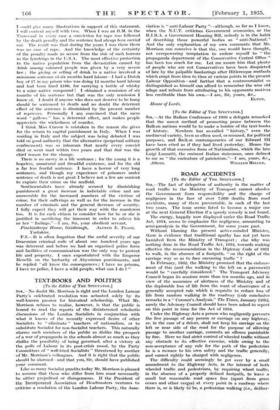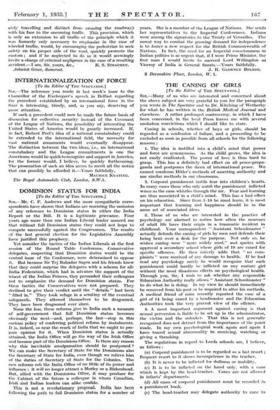ROAD ACCIDENTS [To the Editor of THE SPECTATOR.] SIR, —The fact
of delegation of authority in the matter of road traffic to the Ministry of Transport cannot absolve the Government from responsibility and the charge of negligence in the face of over 7,000 deaths from road accidents, many of them preventable, in each of- the last two years. The issue seems fated to become a major one at the next General Election if a speedy remedy is not found.
The energy, happily now displayed under the Road Traffic Act, 1934, seems to emphasize the negligence, amounting to semi-paralysis in the Government, for some years past.
Without blaming the present active-minded. Minister, there is evidence that traditional apathy has not yet been banished from the Ministry of Transport ; else why was nothing done in the Road Traffic Act, 1934, towards making effective the recommendation in the Highway Code of 1931 to walk, in the absence of a footpath, " on the right of the carriage way so as to face oncoming traffic " ?
In February, 1932, the Ministry promised that the enforce- ment of this (and the walking to the left on a pavement) would be " carefully considered." The Transport Advisory Council began its sessions more than ten months ago, and in view of the assurance of alertness of the Ministry and of the deplorable loss of life from the want of observance of a generally accepted rule which is requisite to reduce Ioss of life from random walking in the roadway (vide conclusive remarks in a " Coroner's Analysis," The Times, January 12th), surely the Advisory Council should have been asked to report on this point in time for the Act of 1984.
Under the Highway Acts a person who negligently prevents the free passage of any person or carriage on any highway, or, in the case of a driver, shall not keep his carriage on the left or near side of the road for the purpose of allowing passage to another carriage, commits an offence punishable by fine. Here we find strict control of wheeled traffic without any obstacle to its effective exercise, while owing to the non-acceptance of any rule for the path of the pedestrian he is a menace to his own safety and the traffic generally, and cannot rightly be charged with negligence.
The difficulty could seemingly be got over by a small amendment to the Highway Acts, in the interest of both wheeled traffic and pedestrians, by requiring wheel traffic, in the absence of a properly defined footpath, to leave a small but reasonable road space free (apart from grass ceases and other verges) at every point in a roadway where there is, or is likely to be, a pedestrian walking (i.e., deliber- ately travelling and distinct from crossing the roadway) with his face to the oncoming traffic. This provision, which is only an extension to all traffic of the principle which it was formerly only necessary to emphasize in the case of wheeled traffic, would, by encouraging the pedestrian to seek safety on his proper side of the road, quickly promote the custom ; and if he neglected to do so it would seemingly invite a charge of criminal negligence in the case of a resulting















































 Previous page
Previous page